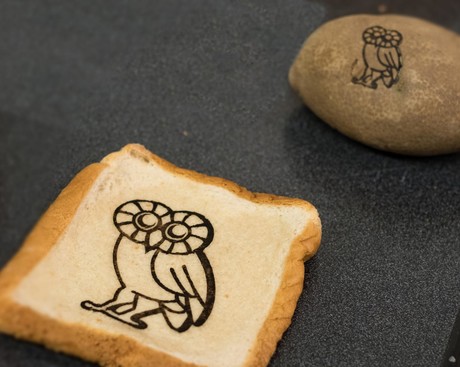Graphene on toast: edible electronics are not far away

US scientists have developed a way to write graphene patterns onto virtually any surface — including food — paving the way for edible electronics capable of tracing the progression of foods from farm to table, as well as detecting harmful organisms.
Graphene is composed of a single layer of carbon atoms arranged in a honeycomb pattern. Stronger than steel, thinner than a human hair and more conductive than copper, it is an ideal building block for the next generation of compact, smart electronics.
Several years ago, James M Tour and his colleagues at Rice University heated the surface of an inexpensive plastic with a laser in air to create something called laser-induced graphene (LIG) — a foam made out of tiny cross-linked graphene flakes. The process can embed or burn patterns that could be used as supercapacitors, RFID antennas or biological sensors.
Based on these results, the researchers theorised that any substance with a reasonable amount of carbon can be turned into graphene. To test this theory, Tour’s team sought to burn LIG into food, cardboard and several other everyday, carbon-based materials.
The researchers used a single laser pulse to convert the surface layer of the target substance into a disorganised jumble of atoms called amorphous carbon, more commonly known as black soot. Then, they conducted multiple laser passes with a defocused beam to convert the soot into graphene.
By defocusing the laser beam, the researchers could speed up the conversion process. And, unlike previous LIG processes, the graphene conversions conducted in these experiments were done at room temperature without the need for a controlled atmosphere box.
Overall, the process demonstrated that LIG can be burned into paper, cardboard, cloth, coal, potatoes, coconuts, toasted bread and other foods. The team’s success was documented in the journal ACS Nano.
As for useful applications of this technology, the researchers suggest that food items could eventually be tagged with RFID antennas made from LIG that could help track where a food originated, how long it’s been stored and how it got to the dining table. They additionally suggest that LIG sensors could be used to uncover E. coli and other harmful organisms lurking in salads, meats and other foods.
Research breakthrough to advance OLED technology
Researchers have observed the luminescence of an excited complex formed by two donor molecules;...
What's next for the semiconductor industry?
For decades, the development of semiconductors has followed Moore’s Law, but with signs of...
Electron–phonon interactions boost 2D semiconductor activity
Researchers have found that electron–phonon interactions can enhance electrical...







